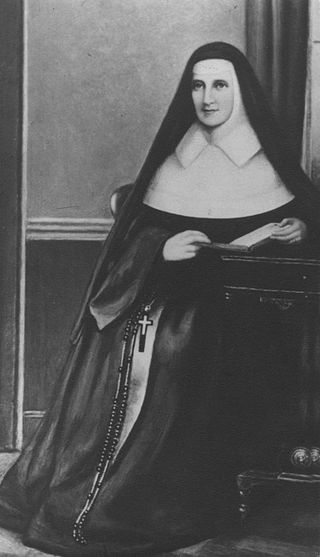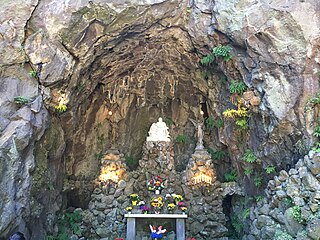
A shrine to the Virgin Mary, or Marian shrine, is a shrine marking an apparition or other miracle ascribed to the Blessed Virgin Mary, or a site on which is centered a historically strong Marian devotion. Such locales are often the destinations of Christian pilgrimages.

Cedar Rapids is a city in and the county seat of Linn County, Iowa, United States. The population was 137,710 at the 2020 census, making it the second-most populous city in Iowa. The city lies on both banks of the Cedar River, 20 miles (32 km) north of Iowa City and 128 miles (206 km) northeast of Des Moines, the state's capital.

The Sisters of Mercy is a religious institute for women in the Roman Catholic Church. It was founded in 1831 in Dublin, Ireland, by Catherine McAuley. As of 2019, the institute has about 6200 sisters worldwide, organized into a number of independent congregations. They also started many education and health care facilities around the world.

The Shrine of the Grotto of the Redemption is a religious shrine in West Bend, Iowa, in the Roman Catholic Diocese of Sioux City. A conglomeration of nine grottos depicting scenes in the life of Jesus, it contains a large collection of minerals and petrifications and is believed to be the largest grotto in the world.

The National Sanctuary of our Sorrowful Mother, popularly known as The Grotto, is a Catholic outdoor altar and sanctuary located in the Madison South district of Portland, Oregon, United States. Constructed in 1924, the sanctuary covers 62 acres (25 ha), set both at the foot of, and atop, a 110 foot (34 m) cliff. It is a ministry of the Servite Friars, Order of Friar Servants of Mary. A large meditation hall whose main chamber is at clifftop level extends down to the foot of the cliff; the cross on the hill is visible many miles away. In addition to a church, there are several thousand feet of trails, including a trail of the Stations of the Cross, along which visitors may pass in contemplation through botanical gardens. The Grotto also features a full-service Conference Center, and a Gift Shop.

Mount Mercy University is a private Catholic university in Cedar Rapids, Iowa, United States. It was founded by the Sisters of Mercy in 1928.

The Mother Mosque of America, once known as The Rose of Fraternity Lodge, in Cedar Rapids, Iowa, United States, is the oldest standing purpose-built mosque in the United States, having been completed in 1934. The Al-Sadiq Mosque in Chicago and the Powers Street Mosque are older by a decade but were converted from existing buildings to be used as a Muslim house of worship.

This is a list of the National Register of Historic Places listings in Linn County, Iowa.

Bethel African Methodist Episcopal Church is located in Cedar Rapids, Iowa, United States. The congregation was established in either 1870 or 1871, which makes this the oldest historically African American church in the city. It had 23 pastors from its inception to 1928, which followed the African Methodist Episcopal Church's practice of itinerant pastors. The congregation grew slowly over this same period. Many African Americans came to Cedar Rapids after the coal industry in Southern Iowa began to collapse. The Rev. Benjamin Horace Lucas, who became pastor here in 1928, was also a catalyst for growth in the congregation. Completed in 1931, this brick Colonial Revival structure replaced a wood-frame structure from 1876. Since its completion, it has served the social and religious needs of the community. It is one of the few surviving links to Cedar Rapid's early African American community as this neighborhood has been nearly obliterated by the development of Mercy Medical Center. The church building was listed on the National Register of Historic Places in 2013.

The Burlington, Cedar Rapids and Northern Railway (BCR&N) was a railroad that operated in the United States from 1876 to 1903. It was formed to take over the operations of the bankrupt Burlington, Cedar Rapids and Minnesota Railway, which was, in turn, the result of merging several predecessor lines, the construction of which began in 1869. The corporate headquarters were in Cedar Rapids, Iowa, and it had operations in Iowa and in Minnesota. It was succeeded by the Chicago, Rock Island and Pacific Railway.

The Linn County Courthouse is located on May's Island in the middle of the Cedar River in Cedar Rapids, Iowa, United States. It, along with the Veterans Memorial Building and two other buildings, is a contributing property to the May's Island Historic District that was listed on the National Register of Historic Places in 1978. The courthouse is the third building the county has used for court functions and county administration.

The Veteran's Memorial Building is located on May's Island in the middle of the Cedar River in Cedar Rapids, Iowa, United States. It is a contributing property to the May's Island Historic District that was listed on the National Register of Historic Places in 1978. The building served as the Cedar Rapids City Hall until it was damaged in the Flood of 2008. The Building underwent a ribbon-cutting ceremony to mark its official re-opening April 15, 2014.

The Iowa Building is a historic structure located in downtown Cedar Rapids, Iowa, United States. It was individually listed on the National Register of Historic Places in 1983. In 2015 it was included as a contributing property in the Cedar Rapids Central Business District Commercial Historic District.

The Security Building is a historic structure located in downtown Cedar Rapids, Iowa, United States. The building is eight stories tall and rises 117 feet (36 m) above the ground. It was designed by the Cedar Rapids architectural firm of Josselyn & Taylor, and it was completed in 1908. The building was individually listed on the National Register of Historic Places in 1977. In 2015 it was included as a contributing property in the Cedar Rapids Central Business District Commercial Historic District.

Josselyn & Taylor was an architectural firm based in Cedar Rapids, Iowa. It was founded in 1882 as the partnership of architects Henry S. Josselyn and Eugene H. Taylor. They were the first academically trained architects to practice in Iowa.

Grant Vocational High School, also known as the Board of Education and the Cedar Rapids School District Central Office, is a historic building located in Cedar Rapids, Iowa, United States. Completed in 1915, this is a rare example of a vocational high school in Iowa as only a handful were ever built. While it offered various student activities in athletics and the arts, its curriculum was based on the manual arts instead of humanities or college preparatory courses. A Progressive Era idea, vocational education began in Cedar Rapids in 1904. Within a year there was a call for a dedicated vocational high school. There was much debate as the local school district's regular high school was beyond capacity and there was a need for new elementary schools. Efforts to build the school began with the passage of a bond referendum in 1911. Cedar Rapids architect William J. Brown designed the three-story, brick Prairie School structure and it was built by the F.P. Gould Company of Omaha.

Sokol Gymnasium is a historic building located in Cedar Rapids, Iowa, United States. Sokol is a Czech social and gymnastics organization. It had this three-story, brick, Neoclassical structure built in 1908. It was designed by local architect Charles A. Dieman. The organization used the facility as a social hall and gymnasium until it was inundated by 4 feet (1.2 m) of water in a 2008 flood. It was cleared out and Sokol moved to another building in southwest Cedar Rapids. This building was individually listed on the National Register of Historic Places in 2013. In 2015 it was included as a contributing property in the Cedar Rapids Central Business District Commercial Historic District.

William J. Brown was an American architect based in Cedar Rapids in the U.S. state of Iowa. Brown practiced architecture from 1910 until shortly before his death in 1970.

The Cedar Rapids Central Business District Commercial Historic District is a nationally recognized historic district located in Cedar Rapids, Iowa, United States. It was listed on the National Register of Historic Places in 2015. At the time of its nomination it consisted of 60 resources, which included 46 contributing buildings, one contributing structure, 12 non-contributing buildings, and one non-contributing structure. Cedar Rapids was platted on the east bank of the Cedar River as Rapids City in 1841, and it was incorporated under the same name in 1849. Kingston was established on the west bank of the river in 1852. The two smaller communities consolidated in 1870 as Cedar Rapids. The streets were laid out parallel and perpendicular to the river, which flowed from the northwest to the southeast. The Chicago, Iowa and Nebraska Railroad was the first to arrive in the community in 1859 and the tracks were laid on Fourth Street on the eastern edge of the central business district. The first bridge across the river was built at Third Avenue in 1871.

Oak Hill Cemetery is a rural cemetery located in Cedar Rapids, Iowa, United States. It was listed as a historic district on the National Register of Historic Places in 2013. At the time of its nomination it consisted of 17 resources, which included 13 contributing buildings, one contributing site, two contributing structures, and one contributing object.
























